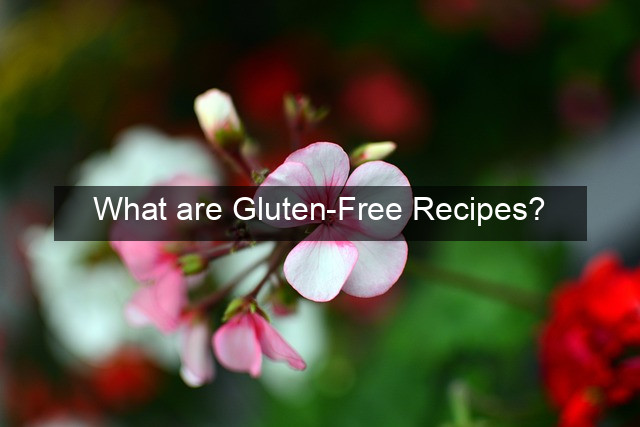What are Gluten-Free Recipes?

- What are Gluten-Free Recipes?
- What are Gluten-Free Recipes?
- Exploring Gluten-Free Grains and Flours
- Understanding Gluten-Free Alternatives
- Baking with Gluten-Free Flours
- Creating Delicious Gluten-Free Meals
- Savory Gluten-Free Dishes
- Gluten-Free Desserts and Treats
- Living a Gluten-Free Lifestyle
- Tips for Gluten-Free Success
- Conclusion
- Frequently Asked Questions
- What is gluten?
- Why go gluten-free?
- What are some common gluten-free flours?

What are Gluten-Free Recipes?
Imagine a world where bread, pasta, and pastries are off-limits. For individuals with celiac disease or gluten sensitivity, this is a daily reality. Gluten-free recipes provide a pathway to enjoying delicious and satisfying meals without the discomfort and health risks associated with gluten consumption. Gluten, a protein found in wheat, barley, and rye, can trigger a range of symptoms, from digestive issues to skin rashes and even neurological problems. Embracing a gluten-free lifestyle often means rethinking traditional recipes and exploring alternative ingredients. This journey can be daunting at first, but with the abundance of gluten-free recipes available, it can also be incredibly rewarding, opening up a whole new world of culinary possibilities.
Gluten-free recipes are not just about restrictions; they’re about creativity and adaptation. They involve substituting traditional gluten-containing ingredients with gluten-free alternatives like rice flour, almond flour, tapioca starch, and coconut flour. These substitutions can lead to exciting new flavors and textures, transforming familiar dishes into unique and satisfying meals. Whether you’re a seasoned cook or a kitchen novice, exploring gluten-free recipes can be a fun and enriching experience, allowing you to discover new ingredients and expand your culinary horizons.
Exploring Gluten-Free Grains and Flours
Understanding Gluten-Free Alternatives
A key aspect of gluten-free recipes is understanding the various gluten-free grains and flours available. Rice flour, a staple in many gluten-free kitchens, offers a mild flavor and light texture, perfect for cakes and pastries. Almond flour, with its nutty flavor and slightly coarser texture, adds depth to baked goods and is a great option for breading. Tapioca starch, derived from the cassava root, provides a chewy texture and is often used as a thickener in sauces and soups. Coconut flour, made from dried coconut meat, adds a subtle sweetness and is ideal for creating moist and flavorful baked goods.
Experimenting with different gluten-free flours is crucial for achieving the desired texture and flavor in your recipes. Each flour has unique properties, and understanding how they behave in different applications is essential for success. Some flours, like rice flour, work well on their own, while others, like almond flour, often benefit from being combined with other gluten-free flours or starches to improve their binding properties.
Choosing the right flour blend can make all the difference in your gluten-free recipes. Many pre-made gluten-free flour blends are available, offering a convenient option for those new to gluten-free baking. However, creating your own blends allows you to customize the flavor and texture to your preferences and specific recipe requirements.
Baking with Gluten-Free Flours
Baking with gluten-free flours requires some adjustments to traditional baking techniques. Gluten provides structure and elasticity in baked goods, so its absence can lead to challenges like crumbly textures and a lack of rise. To overcome these challenges, gluten-free recipes often incorporate ingredients like xanthan gum or guar gum, which act as binding agents and help mimic the properties of gluten.
Proper hydration is also crucial when working with gluten-free flours. These flours tend to absorb more liquid than wheat flour, so it’s essential to follow recipe instructions carefully and adjust the liquid content as needed. Over-mixing can also be a problem, leading to tough and dense baked goods. A gentle hand and just enough mixing to combine the ingredients is usually sufficient.
Temperature control is another important factor in gluten-free baking. Gluten-free baked goods often require lower baking temperatures and longer baking times to ensure they are fully cooked through. Using an oven thermometer can help ensure accurate temperature control and prevent over-browning or under-baking.
Creating Delicious Gluten-Free Meals
Savory Gluten-Free Dishes
Gluten-free recipes extend far beyond baking, encompassing a wide range of savory dishes. From comforting soups and stews to flavorful stir-fries and pasta dishes, the possibilities are endless. Gluten-free pasta, made from rice, corn, or quinoa, offers a satisfying alternative to traditional wheat-based pasta. Gluten-free bread, while sometimes challenging to perfect, can be enjoyed in sandwiches, toast, and other applications.
Many naturally gluten-free ingredients can be incorporated into savory dishes, adding flavor and nutrition. Fresh vegetables, lean proteins, and healthy fats are all essential components of a balanced gluten-free diet. Experimenting with different herbs, spices, and seasonings can elevate the flavor of your dishes and create exciting new taste combinations.
Adapting traditional recipes to be gluten-free often involves simple substitutions. For example, cornstarch can be used as a thickener in sauces, and gluten-free soy sauce can replace traditional soy sauce. With a little creativity and experimentation, you can enjoy all your favorite savory dishes without gluten.
Gluten-Free Desserts and Treats
Indulging in desserts and treats is still possible on a gluten-free diet. Gluten-free recipes for cakes, cookies, brownies, and pies abound, offering a sweet escape without the gluten. Using gluten-free flour blends or individual flours like almond flour or coconut flour, combined with sweeteners like sugar or honey, allows for the creation of decadent and satisfying desserts.
Many naturally gluten-free ingredients can be incorporated into desserts, adding flavor and texture. Fruits, nuts, and chocolate are all delicious additions to gluten-free treats. Experimenting with different flavor combinations and textures can lead to exciting new discoveries.
Adapting traditional dessert recipes to be gluten-free often requires some adjustments to the ingredients and baking techniques. However, with a little practice and patience, you can recreate your favorite desserts without gluten.
Living a Gluten-Free Lifestyle
Tips for Gluten-Free Success
Successfully adopting a gluten-free lifestyle requires careful planning and attention to detail. Reading food labels carefully is essential to identify hidden sources of gluten. Cross-contamination can be a significant issue, so it’s important to use separate cutting boards, utensils, and cooking surfaces for gluten-free foods.
Eating out can be challenging on a gluten-free diet, but with careful planning and communication, it’s possible to enjoy meals away from home. Many restaurants now offer gluten-free options, and some are entirely gluten-free. Communicating your dietary needs clearly to restaurant staff is crucial for ensuring a safe and enjoyable dining experience.
Building a supportive network can be invaluable for navigating the challenges of a gluten-free lifestyle. Connecting with other individuals living gluten-free, either online or in person, can provide valuable resources, tips, and emotional support.
Conclusion
Embarking on a gluten-free journey can seem daunting, but with the abundance of gluten-free recipes available, it can also be an exciting culinary adventure. From savory dishes to sweet treats, the possibilities are endless. By understanding the properties of gluten-free ingredients and adapting traditional recipes, you can create delicious and satisfying meals without sacrificing flavor or texture. Living gluten-free is not just about restrictions; it’s about embracing new ingredients, exploring new flavors, and rediscovering the joy of cooking and eating.
Gluten-free recipes empower individuals with celiac disease and gluten sensitivity to take control of their health and enjoy a full and flavorful life. With a little creativity and perseverance, anyone can thrive on a gluten-free diet and discover a whole new world of culinary possibilities.
Frequently Asked Questions
What is gluten?
Gluten is a protein found in wheat, barley, and rye.
Why go gluten-free?
People go gluten-free for various reasons, including celiac disease, gluten sensitivity, and other health concerns.
What are some common gluten-free flours?
Common gluten-free flours include rice flour, almond flour, tapioca starch, and coconut flour.
| Flour | Description |
|---|---|
| Rice Flour | Mild flavor, light texture |
| Almond Flour | Nutty flavor, slightly coarser texture |
- Rice flour
- Almond flour
- Tapioca starch



